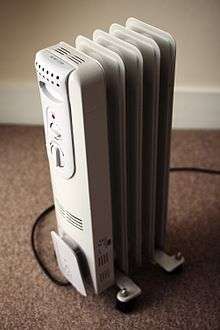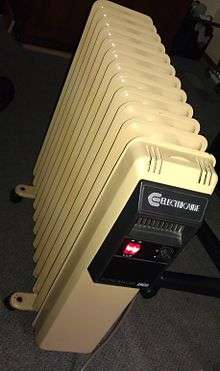Oil heater
An oil heater, also known as an oil-filled heater, oil-filled radiator, or column heater, is a common form of convection heater used in domestic heating. Although filled with oil, it is electrically heated and does not involve burning any oil fuel; the oil is used as a heat reservoir (buffer), not as a fuel.


Function
Oil heaters consist of metal columns with cavities inside which a heat transfer oil flows freely around the heater. A heating element at the base of the heater heats up the oil, which then flows around the cavities of the heater by convection. The oil has a relatively high specific heat capacity and high boiling point. The high specific heat capacity allows the oil to effectively transfer thermal energy from the heating element, while the oil's high boiling point allows it to remain in the liquid phase for the purpose of heating, so that the heater does not have to be a high pressure vessel.
The heating element heats the oil, which transfers heat to the metal wall through convection, through the walls via conduction, then to the surroundings via air convection and thermal radiation. The columns of oil heaters are typically constructed as thin fins, such that the surface area of the metal columns is large relative to the amount of oil and element which provides the warmth. A large surface area allows more air to be in contact with the heater at any point in time, allowing for the heat to be transferred more effectively, which results in a surface temperature which is safe enough to touch. The relatively large specific heat capacity of the oil and metal parts means this type of heater takes a few minutes to heat up and cool down, providing a short-term thermal store.
Efficiency
Although oil heaters are more expensive to run and provide far less spatial heating than gas heaters, they are still commonly used in bedrooms and other small-to-medium-sized enclosed areas. This is because gas heaters, especially when unflued, are not suitable for bedroom use - gas heaters cannot be used in confined spaces due to the reduced oxygen, and the emissions produced. This leaves electrically powered heaters, such as oil heaters, fan heaters and heat pumps, as the only alternative.
Several efficiency metrics can be measured in regard to heaters, such as the efficiency of heating a room with a given amount of power, and the efficiency of the electrical generator which powers the heater and power loss from transporting the electricity over power lines. Measures may also consider how well a heater keeps the temperature of a space above a certain point. Such a measure would find inefficiencies in heating an already warm room. Many heaters (the majority of available models) are equipped with a thermostat to prevent this inefficient heating, which in turn reduces running costs. This feature was much more common in oil heaters than in the cheaper fan heaters until recently; thus many older oil heaters will be cheaper and more efficient to run than their contemporary fan heaters that lack the thermostat.
Typical oil heaters range in power consumption/output from 300 to 2400 watts, and their length and number of columns is roughly proportional to their power rating. A 2400 watt oil heater is usually approximately 1 meter (3.3 feet) in length.
All electric resistance heaters are 100% efficient,[1] with operating costs determined by their wattage and the length of operating time.[2] A 500 watt heater will take at least twice as long to reach the same thermostat setting as a 1000 watt unit; the total consumption of electricity is the same for both.
By contrast, an electrical heat pump used for home heating typically has an efficiency well above 100%, expressed as its coefficient of performance.[3]
Safety and features
The primary risk of oil heaters is that of fire and burns. In both regards they are generally more dangerous than heat pumps, hydronics and air conditioning, but less dangerous than electric fan heaters or bar radiators; this is due to the surface temperature of each type of heater.
Most modern small heaters have some form of tilt sensor to cut power if they are knocked over or placed on an unstable surface. This can reduce the risk of fire if a heater is knocked over.
From a safety standpoint, it is best to avoid having any object within three feet of an oil heater. Using an oil heater to dry clothes is not recommended by any modern manufacturer. There is a substantial fire risk if flammable materials such as clothing or bedding are left near a heater, especially synthetic fabrics such as polyester, which can melt or burn. Even though the surface temperature of the heater in normal operation is quite low, the extra thermal resistance of the clothing on the heater can cause its surface temperature to rise to the material's autoignition temperature. Some oil heaters contain strong warnings to avoid operation in damp areas (such as bathrooms or laundry rooms) because the moisture and humidity can damage components of the heater itself.
Oil heaters have been known to explode when their thermal fuses fail to shut them off.[4] This can cause fire, thick black smoke, unpleasant odors, oil on walls and other surfaces, and disfiguring scalding.
Some companies offer oil heaters with a fan, to increase the air flow over the heater. Since it is constantly bringing the colder air from the room into contact with the heater, that can improve the rate of heat flow from the heater into the room. The rate of heat flow from the heater into the air in contact with it is higher when there is a greater temperature difference between the heater and the air.
References
- "Electric resistance heating". ENERGY.GOV. Retrieved 12 March 2017.
- http://www.energywise.govt.nz/products-and-appliances/heating/electric
- "Heat Pumps". EECA. EECA. Retrieved 12 March 2017.
- "Oil heater explodes, trial blown". The Southland Times, New Zealand. Retrieved 22 March 2013.